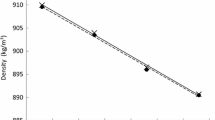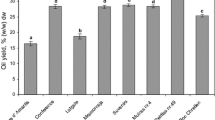Abstract
Seeds of six safflower (C. tinctorius L.) genotypes and 19 accessions of two wild species were analyzed for oil and fatty acid composition. Oil content ranged from 29.20 to 34.00, 20.04 to 30.80 and 15.30 to 20.80% in C. tinctorius, C. oxyacantha Bieb. and C. lanatus L., respectively. The main fatty acids of oleic, linoleic, palmitic and stearic acids composed 96–99% of the total fatty acids in all species. The sum of myristic, palmitoleic, arachidic, and behenic fatty acids in oil of the species ranged from 0.43 to 0.57%. The oleic acid in seed oil of C. tinctorius, C. oxyacantha and C. lanatus ranged from 12.24 to 15.43, 14.11 to 19.28 and 16.70 to 19.77%, respectively. The corresponding ranges for linoleic acid were 71.05 to 76.12, 63.90 to 75.43 and 62.47 to 71.08%. Palmitic acid in seed oil varied from 5.48 to 7.59% in C. tinctorius, 6.09 to 8.33% in C. oxyacantha and 7.44 to 8.78% in C. lanatus. The stearic acid of the seed oil showed a variation of 1.72 to 2.86, 2.50 to 4.87 and 3.14 to 4.79% in genotypes of these species, respectively. The fatty acids composition of oil among the cultivated and wild species were not considerably different, indicating that seed oil of the wild safflower is possibly suitable for human consumption and industrial purposes.
Similar content being viewed by others
References
Robbelen G (1991) Mutation breeding for quality improvement: a case study for oilseed crops. In: Kitto PH (ed) Plant mutation breeding for crop improvement. IAEA, Vienna, pp 3–30
Ohlrogge JB (1994) Design of new plant products: engineering of fatty acid metabolism. Plant Physiol 104:821–826
Hirsinger F (1989) New annual oil crops. In: Robbelen G, Downey RK, Ashri A (eds) Oil crops of the world. McGraw Hill, New York, pp 518–532
Downey RK, Robbelen G (1989) Brassica species. In: Robbelen G, Downey RK, Ashri A (eds) Oil crops of the world. McGraw Hill, New York, pp 339–362
Green AG (1986) A mutant genotype of flax (Linum usitatissimum L.) containing very low levels of linolenic acid in its seed oil. Can J Plant Sci 66:499–503
Rowland GG (1991) An EMS-induced low linolenic acid mutant in McGregor flax (Linum usitatissimum L.). Can J Plant Sci 71:393–396
Vilatersana R, Susanna A, Garcia-Jacas N, Garnatje T (2000) Generic delimitation and phylogeny of the Carduncellus–Carthamus complex (Asteraceae) based on ITS sequences. Plant Syst Evol 221:89–105
Knowles P, Ashri A (1995) Safflower: Carthamus tinctorius (Compositae). In: Smartt J, Simmonds NW (eds) Evolution of crop plants. Longman, Harlow, pp 47–50
Dajue L, Mundel HH (1996) Safflower (Carthamus tinctorius L.). Promoting the conservation and use of underutilized and neglected crops. Monogr. 7. Institut fur Pflanzengenetik und Kulturpflanzenzuchtung (IPK), Gatersleben. Germany and International Plant Genetic Resources Institute, Rome
Ashri A, Knowles PF (1960) Cytogenetics of Safflower (Carthamus L.) species and their hybrids. Agron J 52:11–17
Chapman MA, Burke JM (2007) DNA sequence diversity and the origin of cultivated safflower (Carthamus tinctorius L.; Asteraceae). BMC Plant Biol 7:60
Dittrich M, Petrak F, Rechinger KH, Wagenitz G (1979) Compositae III–Cynareae. In: Rechinger KH (ed) Flora Iranica. No. 139, 468 S.
Heaton TC, Klisiewicz JM (1981) A disease-resistant safflower alloploid from Carthamus tinctorius L. × C. lanatus L. Can J Plant Sci 61:219–224
Weiss EA (2000) Oilseed crops, 2nd edn. Blackwell Science, Oxford
Carvalho IS, Miranda I, Pereira H (2006) Evaluation of oil composition of some crops suitable for human nutrition. Ind Crops Prod 24:75–78
Cosge B, Gurbuz B, Kiralan M (2007) Oil content and fatty acid composition of some safflower (Carthamus tinctorius L.) varieties sown in spring and winter. Int J Nat Eng Sci 1:11–15
AOCS (1993) Official methods and recommended practices. The American Oil Chemists Society, Champaign
SAS Institute, Inc. (1999) SAS/STAT User’s Guide. SAS Institute, Inc., Cary
Mundel HH, Morrison RJ, Huang HC, Keihn F (1993) Registration of ‘AC Stirling’ safflower. Crop Sci 33:201
Falconer DS, Mackay TFC (1996) Introduction to quantitative genetics. Longman, Harlow
Vles RO, Gottenbos JJ (1989) Nutritional characteristics and food uses of vegetable oils. In: Robbelen G, Downey RK, Ashri A (eds) Oil crops of the world. McGraw Hill, New York, pp 63–86
Acknowledgments
The authors wish to thank the Isfahan University of Technology for supporting this research.
Author information
Authors and Affiliations
Corresponding author
About this article
Cite this article
Sabzalian, M.R., Saeidi, G. & Mirlohi, A. Oil Content and Fatty Acid Composition in Seeds of Three Safflower Species. J Am Oil Chem Soc 85, 717–721 (2008). https://doi.org/10.1007/s11746-008-1254-6
Received:
Accepted:
Published:
Issue Date:
DOI: https://doi.org/10.1007/s11746-008-1254-6




